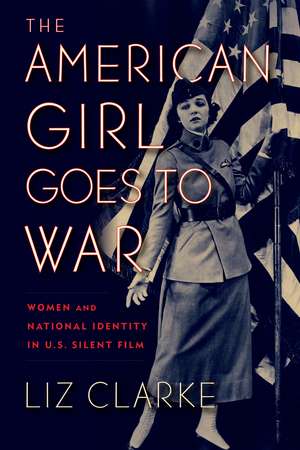The American Girl Goes to War: Women and National Identity in U.S. Silent Film: War Culture
Autor Liz Clarkeen Limba Engleză Paperback – 14 ian 2022 – vârsta ani
During the 1910s, films about war often featured a female protagonist. The films portrayed women as spies, cross-dressing soldiers, and athletic defenders of their homes—roles typically reserved for men and that contradicted gendered-expectations of home-front women waiting for their husbands, sons, and brothers to return from battle. The representation of American martial spirit—particularly in the form of heroines—has a rich history in film in the years just prior to the American entry into World War I. The American Girl Goes to War demonstrates the predominance of heroic female characters in in early narrative films about war from 1908 to 1919. American Girls were filled with the military spirit of their forefathers and became one of the major ways that American women’s changing political involvement, independence, and active natures were contained by and subsumed into pre-existing American ideologies.
Preț: 209.67 lei
Nou
Puncte Express: 315
Preț estimativ în valută:
40.13€ • 41.74$ • 33.13£
40.13€ • 41.74$ • 33.13£
Carte disponibilă
Livrare economică 24 martie-07 aprilie
Preluare comenzi: 021 569.72.76
Specificații
ISBN-13: 9781978810150
ISBN-10: 1978810156
Pagini: 184
Ilustrații: 15 b-w images
Dimensiuni: 152 x 229 x 15 mm
Greutate: 0.25 kg
Editura: Rutgers University Press
Colecția Rutgers University Press
Seria War Culture
ISBN-10: 1978810156
Pagini: 184
Ilustrații: 15 b-w images
Dimensiuni: 152 x 229 x 15 mm
Greutate: 0.25 kg
Editura: Rutgers University Press
Colecția Rutgers University Press
Seria War Culture
Notă biografică
LIZ CLARKE is an assistant professor in communication, popular culture and film at Brock University in Ontario, Canada. She has published articles in Camera Obscura and Feminist Media Histories, as well as papers in edited anthologies New Perspectives on the War Film and Martial Culture, Silver Screen: War Movies and the Construction of American Identity.
Cuprins
List of Illustrations
Introduction
1 American Girls and National Identity
2 Fighting Femininity on Home Soil in Civil War Films, 1908–1916
3 The American Revolution and Other Wars
4 Featuring Preparedness and Peace: America and the European War, Part I
5 From Serial Queens to Patriotic Heroines: America and the European War, Part II
6 The American Girl and Wartime Patriotism
Conclusion
Appendix 1: Civil War Films, 1908–1916
Appendix 2: World War I Films, 1914–1919
Additional Filmography
Acknowledgments
Notes
Selected Bibliography
Index
Introduction
1 American Girls and National Identity
2 Fighting Femininity on Home Soil in Civil War Films, 1908–1916
3 The American Revolution and Other Wars
4 Featuring Preparedness and Peace: America and the European War, Part I
5 From Serial Queens to Patriotic Heroines: America and the European War, Part II
6 The American Girl and Wartime Patriotism
Conclusion
Appendix 1: Civil War Films, 1908–1916
Appendix 2: World War I Films, 1914–1919
Additional Filmography
Acknowledgments
Notes
Selected Bibliography
Index
Recenzii
“Documenting the many heroic women who populated war films of this era, Liz Clarke shows the strength and vitality of female characters onscreen, while remaining attentive to the key role that white femininity played in narratives of American national identity during this period. Framing her analysis within a rich cultural context, Clarke show how essential cinema was to evolving ideas about both nationhood and femininity in the first decades of the twentieth century.”
"This exciting, well-researched work crosses multidisciplinary boundaries and will be of value to those interested in cinema, gender studies, propaganda, history, and political science. Recommended for academic libraries."
Descriere
The American Girl Goes to War demonstrates the predominance of heroic female characters in in early narrative films about war. American Girls were filled with the military spirit of their forefathers and became one of the major ways that American women’s changing political involvement, independence, and active natures were contained by and subsumed into pre-existing American ideologies.















